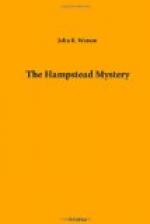The evidence which he intended to call would show that for years past very friendly relations had existed between the prisoner and the murdered man. They had been at Cambridge together and had studied law together in chambers. Their friendship continued after their marriages. The prisoner had married a second time, and at that time Sir Horace Fewbanks was a widower. Sir Horace Fewbanks was what was known as a ladies’ man, and at the previous trial prisoner, as defending Counsel, had tried to bring out that Sir Horace was a man of immoral reputation among women. There was no doubt that the prisoner, during Sir Horace’s absence in Scotland, became convinced that Sir Horace had been paying attention to his wife. There was no doubt that, being a man of a jealous disposition, his suspicions went beyond that. At any rate he wrote a letter to Sir Horace at Craigleith Hall, where the latter was shooting, asking him to come to London at once. In order to induce Sir Horace to return, and in order not to arouse suspicion as to his real object, he concocted a story about a vacancy in the Court of Appeal Bench to which, it appeared, Sir Horace Fewbanks desired to be appointed. In this letter, which would be produced in evidence, the prisoner pretended to be working in Sir Horace’s interests, and offered to meet him on the night of his return at Riversbrook and let him know fully how matters stood. Sir Horace apparently wrote to the prisoner making an appointment with him for the night of the 18th of August. The prisoner kept that appointment, charged Sir Horace with carrying on an intrigue with his wife, and then shot him.
“That is the case for the prosecution which I will endeavour to establish to the satisfaction of the jury,” said Mr. Walters, in concluding his speech, “Of course it is impossible to produce direct evidence of the actual shooting. But I will produce a silent but indisputable witness in the form of a glove which belonged to the prisoner, that he was present in the room in which the murder took place. I will produce evidence to show that the prisoner left his stick behind in the hat-stand in the hall on the night of the murder. These things prove conclusively that he left Riversbrook in a state of considerable excitement. The fact that after the murder was discovered he kept hidden in his own breast the knowledge that he had been there on that night, instead of going to the police and, in the endeavour to assist them to detect the murderer of his lifelong friend, informing them that he had called on Sir Horace, shows conclusively that he went there on a mission on which he dared not throw the light of day.”




